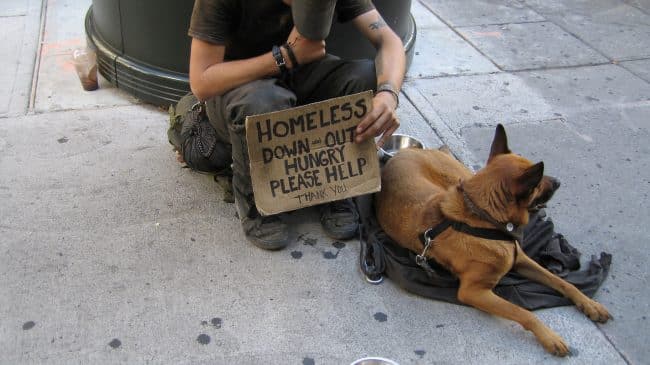Homelessness in America is on the rise for the first time since 2010 due in part to a homelessness surge in Los Angeles and West Coast cities. In 2017, on a single night, there were 553,742 people experiencing homelessness in the United States, according to an Annual Homeless Assessment Report from the U.S. Department of Housing and Urban Development (HUD). As more cities across America struggle to identify ways to end homelessness in their neighborhoods and the stress it places on their budgets, public-private partnerships (PPPs) offer some promising solutions.
It would cost around $20 billion per year to eliminate homelessness entirely in the U.S., according to a 2012 statement made by a HUD official. President Trump’s 2019 budget proposal seeks a much lower $2.4 billion in HUD funding to end homelessness, placing much of the burden in the hands of state and local governments.
Lower-level governments, which aren’t much better equipped to handle homeless populations, are learning that trying to care for the homeless on the streets appears to be more costly than housing them. For instance, a 2014 study by the Central Florida Commission on Homelessness found that “for long-term, chronically homeless individuals, including repeated incarcerations, emergency room use and inpatient hospitalizations,” Florida residents pay $31,065 per chronically homeless person every year, as opposed to paying only $10,051 per homeless person to provide permanent supportive housing and services such as job training and healthcare.
Similarly, a 2014 study from the University of North Carolina at Charlotte examined Moore Place—an apartment complex used to house homeless people—and found it’s cheaper to take homeless off the streets and into housing with services. Out of the 85 tenants participating, in the year after moving into Moore Place, tenants saved $1.8 million in health care costs and they spent 84 percent fewer days in jail, with a 78 percent drop in arrests.
There is a long history of combining government, nonprofit and philanthropic resources to achieve larger societal aims like reducing recidivism, operating animal shelters and urban parks, and in this case, ending homelessness.
One organization participating in PPPs to keep homeless off the street is Your Way Home (YWH) in Montgomery County, Pennsylvania. YWH is an award-winning, program that brings together county government, nonprofits, and other philanthropic groups to work together in a unified, coordinated way to end homelessness in the county.
There are three major components of the YWH leadership system and partnership which make Montgomery County unique in its approach to ending homelessness.
First, there is a dedicated YWH Operations Team—housed within the county Department of Health and Human Services—responsible for system management and partnership backbone support.
Second, part of the collective impact model is the YWH Advisory Council, which is comprised of up to 25 public-private and non-profit leaders that are appointed by the county commissioners. They provide guidance, feedback, support, and resources for achieving the overall vision of ending homelessness.
The final piece of the YWH leadership system is the philanthropic partnership. They focus on the YWH Initiative Fund, which is a private fund housed at the Montgomery County Foundation. YWH pools its grant funding, with funds managed by the Operations Team, guided by the Advisory Council, and ultimately deployed to core system service providers.
In 2017, YWH reported a 37 percent decrease in homelessness, a nearly 50 percent reduction in the number of homeless families, and a nearly 40 percent decline in child homelessness since 2013. Prior to the launch of the PPP in 2014, homelessness was increasing.
The organization attributes the five-year decline to strategic organization changes consistent with an approach dubbed “Housing First” that helps the most vulnerable people in the county find permanent housing and stay in stable conditions by connecting them to the community, health, human, and financial services to prevent future homelessness.
Under Housing First, residents experiencing a housing crisis can call 211 (powered by United Way) and reach the Montgomery County Homeless Prevention Center—a centralized call center system operated by YWH Call Center Specialists—and are screened for referral to emergency services (i.e. 911).
Depending on need, they could be referred to resources. including Veteran’s Affairs, substance abuse and childcare programs. Next, residents would be referred to Housing Resource Centers (operated by one of YWH’s community partners) for prevention, diversion, and rapid re-housing (an approach that reduces the time individuals are homeless by removing as many barriers to entry as possible). Screening through the call center this way conserves resources and reduce costs.
Finally, individuals or families would go to conveniently located Housing Resource Centers where trained specialists offer homelessness prevention that involves coaching, fair housing counseling, landlord-tenant relations or temporary utility assistance.
The research center specialists also work to divert homeless people from entering the shelter system by offering temporary financial assistance for moving, security deposits, or first/last month’s rent. They can rapidly re-house individuals or families into permanent housing and provide temporary rental subsidies, housing stability services, and access to mainstream resources. If needed, they could also connect vulnerable populations to the necessary interventions, mainstream resources and/or permanent supportive housing.
Without the crucial assistance from PPPs, cities and states would struggle to confront homelessness. Community cooperation through public-private partnerships has been the key to success in reducing homelessness in Montgomery County and can serve as a successful model to use in cities and states across the country.
